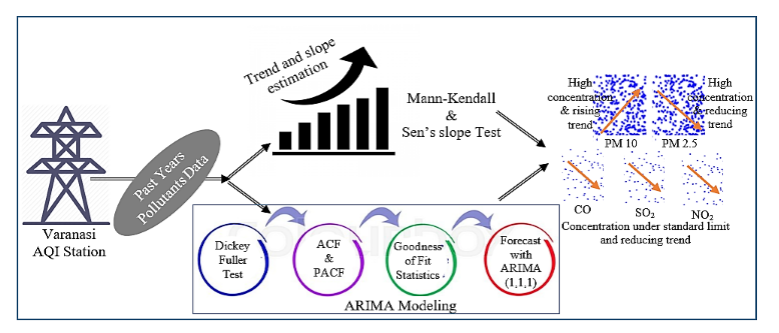Document Type : ORIGINAL RESEARCH ARTICLE
Authors
1 Department of Mechanical Engineering, Indian Institute of Technology, Varanasi, India
2 Department of Mechanical Engineering, Brahmdevdata Mane Institute of Technology, Solapur, India
Abstract
The study provides a statistical trend analysis of different air pollutants using Mann-Kendall and Sen’s slope estimator approach on past pollutants statistics from air quality index station of Varanasi, India. Further, using autoregressive integrated moving average model, future values of air pollutant levels are predicted. Carbon monoxide, nitrogen dioxide, sulphur dioxide, particulate matter particles as PM2.5 and PM10 are the pollutants on which the study focuses. Mann-Kendall and Sen’s slope estimator tests are used on summer (February-May), monsoon (June-September) and winter (October-January) seasonal data from year 2013 to 2016 and trend results and power of the slopes are estimated. For predictive analysis, different autoregressive integrated moving average models are compared with goodness of fit statistics, and the observed results stated autoregressive integrated moving average (1,1,1) as the best-suited for forecast modeling of different pollutants in Varanasi. Autoregressive integrated moving average model (1,1,1) is also used on the annual concentration levels to predict forthcoming year's annual pollutants value. Study reveals that PM 10 shows a rising trend with predicted approximate annual concentration of 273 µg/m3 and PM2.5, carbon monoxide, nitrogen dioxide and sulphur dioxide show a reducing trend with approximate annual concentration of 139 µg/m3, 1.37 mg/ m3, 38 µg/m3 and 17 µg/m3, respectively, by the year 2030. The study predicted carbon monoxide, nitrogen dioxide andsulphur dioxide concentrations are lower and PM10 and PM2.5 concentrations are much higher to the standard permissible limits in future years also, and specific measures are required to control emissions of these pollutants in Varanasi.
Graphical Abstract
Highlights
- Increasing trend in concentration of particulate matter particle of size up to 10 µm (PM 10) and decreasing trend for PM 2.5, CO, NO2 and SO2 in Varanasi
- ARIMA (1,1,1) model is best suited for predicting the concentration of air pollutants for upcoming years in Varanasi
- High concentration levels of PM 10 and PM 2.5 in future years suggest requirement of strict measures to control the emissions of these pollutants.
Keywords



Letters to Editor
[1] Letters that include statements of statistics, facts, research, or theories should include appropriate references, although more than three are discouraged.
[2] Letters that are personal attacks on an author rather than thoughtful criticism of the author’s ideas will not be considered for publication.
[3] Letters can be no more than 300 words in length.
[4] Letter writers should include a statement at the beginning of the letter stating that it is being submitted either for publication or not.
[5] Anonymous letters will not be considered.
[6] Letter writers must include their city and state of residence or work.
[7] Letters will be edited for clarity and length.
Send comment about this article